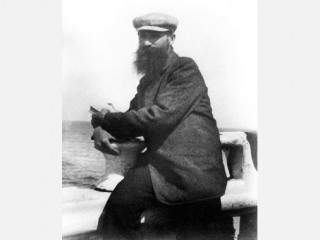
Aristide Maillol biography
Date of birth : 1861-12-08
Date of death : 1944-09-28
Birthplace : Banyuls-sur-Mer, France
Nationality : French
Category : Famous Figures
Last modified : 2010-12-16
Credited as : Artist painter-sculptor, printmaker and designer,
The sculpture of the French artist Aristide Maillol is classical in form and spirit but does not imitate ancient art or the academic, Greco-Roman traditions. He was also a painter, printmaker, and tapestry designer.
Aristide Maillol was born on Dec. 8, 1861, in Banyuls-sur-Mer, the son of a ship captain who was also a fisherman and cultivator of vineyards. Maillol, second of four children, was brought up in a region once colonized by the ancient Greeks. His home looked out on the Mediterranean. After attending a local school, he was sent to Perpignan to further his education. He began to draw and to develop an interest in art early in life.
At the age of 21, Maillol became a painting student of Jean Leon Gereme at the Ecole des Beaux-Arts in Paris. Dissatisfied, he turned to other teachers, Alexandre Cabanel and Jean Paul Laurens, but then rejected official instruction as sterile and pointless. Maillol was not alone in his opinion: other artists of consequence throughout the second half of the 19th century reacted in a similar manner.
In 1884 Maillol saw the paintings of Paul Gauguin and Maurice Denis. "Gauguin's painting was a revelation to me!" he exclaimed. Indeed it was. Maillol's style changed, but without assuming the mannerisms of Gauguin's style, only its breadth and innocence. Later, in 1894, Gauguin saw some of Maillol's tapestries and said they could not be "too highly praised." The two artists met once, but they never developed a close relationship.
In 1889 Maillol began to design tapestries. He was inspired by medieval examples he had seen at the Musée de Cluny in Paris. He returned to Banyuls to set up a small tapestry factory and hired some local women to assist him. He made the designs and dyed the wool to obtain colors not found in commercial wools. His drawings, paintings, and cartoons reveal the influence of the Nabis, many of whom he knew personally. Superintending his factory was such a strain that his eyesight began to fail.
About 1898 Maillol began to model in clay, and soon he confined himself exclusively to sculpture. By 1900 he had developed a style so distinctive and personally satisfying that it was to undergo no critical change thereafter. He depicted only the human figure, especially the female nude. A fine example of his early work is The Mediterranean (1901), a larger-than-life, seated female figure. It is a strong work and betrays no lack of experience or confidence.
In 1902 Maillol had his first one-man exhibition, which was a great success and led to a number of commissions. His earliest pieces were carved in stone and wood. After 1905 he concentrated on modeling and having the completed works cast in bronze. He was to follow this procedure throughout his life.
In 1904 Maillol had established a studio at Marly-le-Roi near Paris. He continued to spend his winters in his hometown. He did little traveling usually, but he did go to Greece, primarily to view ancient sculptures in the original. Seeing them caused no change in his work. Rather it seemed to confirm him in his approach. In a sense, Maillol had already recreated the Greek spirit without imitating the sculpture.
In 1906 Maillol was commissioned to design a monument in memory of the socialist Louis Blanqui, who had spent half of his life in prison in defense of his principles. For it Maillol conceived his Chained Action, an aggressively striding female nude; this sculpture is not typical of his production. Most of his figures appear placid, self-contained, and yet earthy, almost sensuous. They closely resemble those of Auguste Renoir; like Renoir's nudes, they are refined, sensitive, innocent pagans. It is as if they were untouched by time or other external pressures—except possibly for a slight air of melancholy. Maillol's Three Nymphs (1936-1938) exhibits no appreciable difference over his earlier works. In fact, the figures are very close in pose and attitude to his Pomona (1907).
In 1912 Maillol executed woodcuts for Virgil's Eclogues, and in 1931 he made lithographs to illustrate Emile Verhaeren's Belle Chair. Maillol died on Sept. 28, 1944, in Perpignan.
Waldemar George, Aristide Maillol (1965), with a biographical sketch by D. Vierny, and John Rewald, Maillol (1939), have many reproductions. The texts provide the basic biographical information, but they are essentially tributes to the artist. Rewald is the editor of The Woodcuts of Aristide Maillol: A Complete Catalog with 176 Illustrations (1943).
















